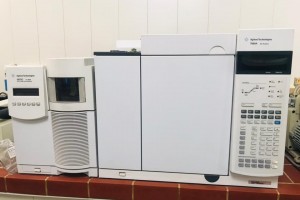
The College of Education for Pure Sciences, Department of Chemistry, discussed a doctoral thesis on preparing complexes of azo dyes derived from diketones and studying their analytical and medical applications.
The thesis submitted by the researcher included (Noor Abdul Hakim Abdul Razzaq Al-Bahili)
The study included the preparation of seven new azo-beta-ketone compounds. The direct method was used to prepare azo compounds (N1-N5,N8,N9). The azo-beta-diketone compounds were prepared in two steps, the first of which included the preparation of diazonium salt (nitrification) of three amines:
[(Luminol)-(Procaainehydrochloride)-(Sulfamerazine)-(Sulfaguanidine)]
. The second step was a coupling process to obtain the required azo compounds, in which the diazonium solution was gradually added with continuous stirring alternately to the acetyl acetone and benzoyl acetone solution.
It was diagnosed using the micro-analysis technique (C.H.N), and it was also diagnosed using proton nuclear magnetic resonance (1H-NMR) and infrared technology (FT-IR), as well as the compounds were diagnosed by mass spectrometry. The visible rays spectra of the compounds prepared with different solvent group were studied.
The complexes were characterized using FT-IR, mass spectrometry, TG and C.H.N. As well as studying molar conductivity, magnetic sensitivity, and atomic-flame absorption with nickel and copper(II).
The medical applications of the ligands and their complexes were studied, their efficacy as antioxidants was measured and compared with vitamin C (ascorbic acid) as a positive control by DPPH assay, using a concentration of 1000 µg/ml, and using a UV.vis device. The results showed that the ligands N1, N2, N8 and N9 had good inhibitory values against S. aureus bacteria, where the inhibition radii reached (11, 14, 13, 12 mm) respectively, while the ligands N3, N4 and N5 No efficacy was shown against the bacteria themselves. As for the complexes (N1Cu, N2Cu, N4Cu, N8Cu) they showed the activity of the direction of S. aureus bacteria, where the inhibition radii reached (11, 9, 11, 12, 10 mm), respectively.
Objectives of the study: Preparation and characterization of a series of azo-beta-diketone glycandes. Studying the effect of solvents on ligands. Preparation and characterization of complexes of copper (II) and nickel (II) metals from the prepared ligands. Study of the thermal stability and magnetic sensitivity of the prepared complexes. Studying the effect of some ligands and their prepared complexes as anti-cancer agents. Study of the biological activity of the prepared ligands and copper complexes.
Thesis concluded
Synthesis of new medicinal ligands derived from beta-diketone compounds
The ability of the prepared azo compounds as clinics to form stable complexes with copper(II) and nickel(II). The results of the IR, 1HNMR and Mass spectrometer tests proved the validity of the proposed compounds. The prepared azo compounds exhibited two-token clinics with both copper(II) and(II) nickel. All the prepared copper(II) complexes have the tetrahedral (square planar) geometric shape, while the nickel(II) complexes are hexagonal (octahedral). The ligands N1, N2, and N8 proved to have excellent inhibition activity against two types of bacteria S. aureus and E. coli, and it was noted that the N9 ligand had activity against bacteria of type S. aureus only, and it was noted that the ligands N3, N4, and N5 had no activity Inhibitory towards any type of bacteria studied. While the copper (II) complexes CuN1, CuN2, and CuN8 proved to have excellent inhibition activity against two types of bacteria S. aureus and E. coli, and it was noted that CuN3 had inhibitory activity against bacteria of type E. coli only, and CuN4 and CuN9 It has an inhibitory activity against S. aureus bacteria, and the CuN5 complex has no inhibitory activity against any type of bacteria. The results noted that the prepared ligands have below average antioxidant activity, and that the copper (II) complexes have excellent antioxidant activity, except for the CuN1 and CuN4 complexes, which have below average activity. The results showed that the prepared ligands have weak anti-growth activity against the growth of human breast cancer cells (MCF-7), and that the copper (II) complexes have excellent activity for the growth of human breast cancer cells (MCF-7), except for the CuN5 complexes, which have a very weak activity
 .
.







